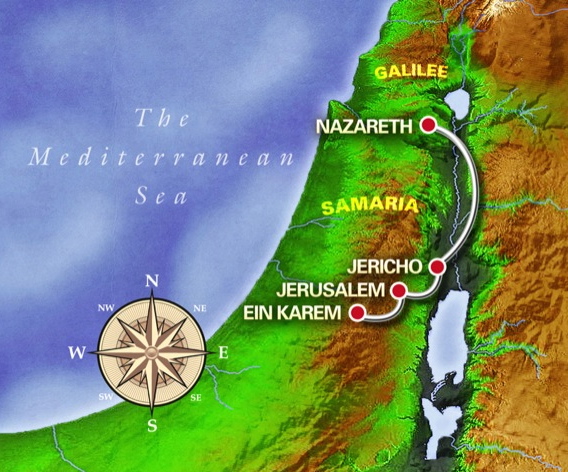4TH SUNDAY OF ADVENT: THE MISSION OF CHRISTMAS

These past few days, many people have been taking the hard and long journey going home for Christmas. One could just admire all the hardship and troubles that people endure just to be back in time for Christmas to visit their families, loved ones and friends: the long queue and waiting at terminals, enormous traffic, longer trips because of the traffic, exhaustion, hunger, lack of sleep during the trip. But all their tiredness disappear once they arrived home and see their loved ones.
In today’s gospel, we hear of the visit of Mary to her cousin Elizabeth. Mary took at least three days of long and arduous journey to reach the home of Elizabeth (more on this later). But when Mary arrived, her tiredness was transformed into joy. As soon as Elizabeth heard the sound of Mary’s greeting, very likely “shalom” (peace), the infant in Elizabeth’s womb “leaped for joy” at the recognition of the soon to be born savior in Mary’s womb. Because of this, Elizabeth became filled with the Holy Spirit, and she burst out in joyful salutation:
“Blessed are you among women,
and blessed is the fruit of your womb.
And why has this happened to me, that the mother of my Lord comes to me?
And blessed is she who believed that there would be a fulfillment
of what was spoken to her by the Lord.”
Pope Francis describes this visitation scene as a scene of overflowing joy from both soon-to-be mothers because of the coming of Jesus.
… When Mary arrives, joy overflows and gushes from their hearts, because the invisible but real presence of Jesus fills everything with meaning: life, family, the salvation of the people. Everything!
The joyful and blessed encounter between Elizabeth and Mary notwithstanding, we cannot underestimate the importance of the long and arduous journey that Mary embarked to reach Elizabeth. She took off from Nazareth, a Galilean city west of the Sea of Galilee and travelled to Ein Karem, the Judean village where Elizabeth and Zechariah lived. This covers a distance of between 128 and 160 kilometers. Luke does not mention whether Mary made any preparations for the trip or how she traveled. She may have gone on foot or as part of a caravan. We don’t know if she traveled alone or whether St. Joseph accompanied her, or SS. Anne or Joachim. In Mary’s day, a person traveling by foot could cover about 32 kilometers per day. If Mary walked to Elizabeth’s home, it would have taken her four to five days. If she accompanied a caravan, she would have arrived in about three days.

Such a journey would have been dangerous, especially for a young girl alone. Mary demonstrated her courage as well as her desire for confirmation of God’s plan. She overcome any fear she may have had about surrendering to God’s call on her life or facing the possible danger involved in confirming his will. Such complete surrender freed her to act in confidence.
In going to Ein Karim, Mary became the first missionary, the first bearer of the Good News. Despite being pregnant with Jesus, the word incarnate (logos), in her womb, she journeys through the hill country to the town of Juda. English theologian John Saward refers to this image of Mary on her journey to Elizabeth as the “Logos carrying Virgin.”[1] In this journey, Mary became the first disciple and missionary of the Logos (Word). Indeed she is the Theotokos—bearer of God in our world.
Mary stayed 3 months to be with Elizabeth to continue to accompany and assist Elizabeth into the more delicate three months remaining of her pregnancy. We do no know, whether Mary was still present when Elizabeth gave birth to John the Baptist. This further showed, however, that Mary, despite herself being pregnant, was able to be present and minister to someone who was more in need.
What is this story telling us about Christmas?
Christmas is a joyful celebration that essentially leads to vibrant mission. The celebration of the incarnation of Jesus overflows with life, joy and goodness that it cannot be kept just to ourselves and lived only at this time of the year. It has to be lived, shared and proclaimed to others, to the whole world, throughout the year. As we sing in the famous Tagalog Christmas carol, Sa Maybahay,
Ang pag-ibig ‘pag siyang naghari (When love reigns)
Araw-araw ay magiging Pasko lagi (Everyday will be Christmas!)
Like Mary, we are all called to be Theotokos—God-bearers. We are all called to share the good news of Emmanuel, God is with us, not just with our lips but also with our feet, with all our heart and soul all the days of our lives.
I am passionate about the intersection between new media and technology. I continue to research and apply new media in theology and vice-versa. I am also a fan of Our Mother of Perpetual Help and her continuing relevance in today’s digital world.
View all posts by Baclaran Phenomenon







